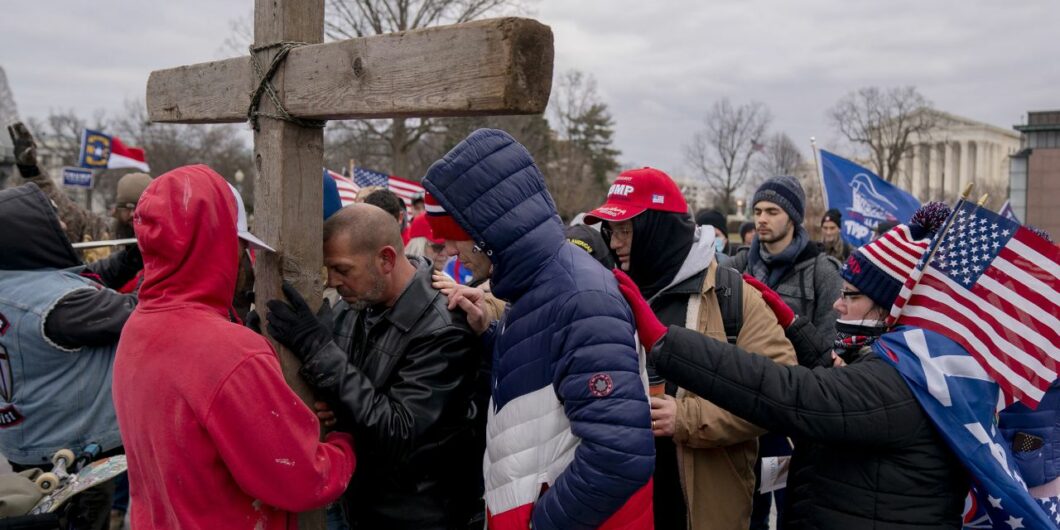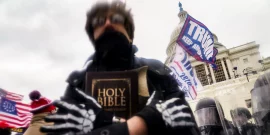We have a strong obligation to call out our own side's ideological missteps.
American Theocrats?
In a common telling of the tale, since the late 1970s, Christian theocrats have been on the verge of taking over America. In the twentieth century, they were called the Religious Right, but since 2006 they have often been called Christian nationalists. Most books written about this amorphous group are polemical in nature, often authored by journalists or activists who rely mostly on anecdotes and rhetoric. With refreshing honesty, at least one of these authors acknowledges that his book is “not a work of academic history but an argument, an attack. Specifically, it is an attack on Christian nationalism.”
Over the past several years, social scientists have attempted to describe and measure American Christian nationalism. Perhaps most prominently, Andrew Whitehead and Samuel Perry describe Christian nationalism as “an ideology that idealizes and advocates a fusion of American civic life with a particular type of Christian identity and culture” that “includes assumptions of nativism, white supremacy, patriarchy, and heteronormativity, along with divine sanction for authoritarian control and militarism.” According to them, 51.9% of Americans fully or partially embrace this toxic ideology.
There are good reasons to believe that Whitehead and Perry overstate the percentage of Americans who support anything like what they call Christian nationalism, and recent studies offer more reasonable accounts of the phenomenon. Among them are Paul J. Djupe’s, Andrew R. Lewis’s, and Anand E. Sokhey’s The Full Armor of God: The Mobilization of Christian Nationalism in American Politics. Their book, which utilizes past surveys as well as those they designed and ran themselves, deepens our understanding of Christian nationalism by carefully considering how the phenomenon should be measured and by addressing why it has manifested itself in recent years.
Whitehead and Perry attempt to measure Christian nationalism by utilizing a battery of statements to which individuals offer responses. Respondents state whether they strongly disagree, disagree, are uncertain, agree, or strongly agree with the following statements:
- The federal government should declare the United States a Christian nation.
- The federal government should advocate Christian values.
- The federal government should enforce strict separation of church and state. (The responses to statement 3 are “reverse coded” by the authors so that strong agreement with this proposition is recorded in the same way that strong disagreement is recorded for the other five.)
- The federal government should allow the display of religious symbols in public spaces.
- The success of the United States is part of God’s plan.
- The federal government should allow prayer in public schools.
All but the first of these statements are ambiguous, and strong agreement with them does not mean that one is a Christian nationalist—at least as most scholars define the concept. For instance, one could strongly agree that the federal government should advocate Christian values such as peace and justice, reject the sort of church-state separation that would require a 1925-era cross on public land to be torn down, and think that voluntary prayer should be allowed in public schools without improperly fusing “American civic life with a particular type of Christian identity and culture.”
Djupe, Lewis, and Sokhey recognize that the statements utilized by Whitehead and Perry could be sharpened, so they reformulated three of them (changes in bold):
- The federal government should advocate Christian values for the benefit of Christians.
- The federal government should allow Christian prayer in public schools.
- The federal government should allow the display of Christian symbols in public spaces.
The reformulated statements do a better job of getting at whether respondents believe Christianity should be favored above other faiths. When the authors ran their own survey, they found that slightly fewer respondents agreed with two of the more exclusive statements. Notably, 2% fewer strongly agreed with the first statement (16.2% vs. 18.1%) and 5% fewer strongly agreed with the second (24.7% vs. 29.8%).
Of the six statements utilized by Whitehead and Perry, only the first measures something reasonably called Christian nationalism. Of the altered statements, the first does as well as it clearly involves favoring Christians over others. However, the authors’ changes do little to fix the problems with the other two statements.
Since at least 1981, the Supreme Court has held that voluntary prayer may be allowed in public schools. Surely this includes Christian prayer, just as it must include prayers offered by adherents to other religions. Indeed, it would be profoundly illiberal to prohibit voluntary prayer (Christian or otherwise) in public schools. The relevant question is not whether voluntary Christian prayer should be allowed; it is whether the federal government should permit teachers or other school officials to lead students in Christian prayer.
Like so many students of Christian nationalism, the authors too readily conflate a lack of support for a wall of separation between church and state with an improper fusion of God and country.
Similarly, one could easily think that Christian symbols such as the Bladensburg Cross should be permitted on public land, while at the same time believing symbols from other faiths should be permitted as well. Strongly agreeing with either of the last two rewritten statements does not mean that one favors Christianity above other faiths. These two statements should be sharpened, but responses to the first revised statement may suggest that it wouldn’t make much difference.
Many attempts to measure Christian nationalism are problematic, but there is no question that too many Americans (about 20%, by my calculations) improperly conflate Christianity and the United States. And there are worrisome correlations between Christian nationalism and adhering to views that pose a threat to American democracy. For instance, Christian nationalists are “less likely to reject undemocratic processes” and agree with the statement “I would support an organization that fights for my group’s rights even if they sometimes break the law.” Only 20–30% of strong Christian nationalists embrace such views, but a relatively small number of people can still do a great deal of harm.
The authors contend that a major contribution of their book is to answer the question “Why now?” That is, why is Christian nationalism manifesting itself at this point in time? At one level, they concede that Christian nationalism isn’t completely new; it can be and regularly is traced back to the late 1970s and the formation of the Religious Right. Many of the chief concerns of that movement—e.g., banning abortion, returning teacher-led prayer to public schools, and banning pornography—remain the same.
But some things have changed. Perhaps most notable is the increase of what the authors call “Christian persecution rhetoric.” Until recently, the vast majority of Americans identified themselves with mainstream Christian denominations. Although members of smaller Christian sects, such as Amish, sometimes ran afoul of laws that prevented them from acting on their religious convictions, this seldom happened to mainstream Christians.
Over the past two decades, the percentage of Americans who identify with mainstream Christian denominations has fallen, and governments have passed laws that attempt to force members of mainstream Christian groups to violate their religious convictions. For instance, some states have attempted to require creative professions to participate in ceremonies to which they have religious objections. Conservative political elites, the authors argue, have effectively drawn upon such stories to convince conservative Christians that they are being persecuted, and they utilize this fear to motivate them to engage in politics.
The authors concede that discrimination against Christians “could be real,” but they suggest that “the fact that perceptions of discrimination against Christians are highest in the most Christian states like Mississippi strains credulity.” Yet it seems likely that Christians in Mississippi recognize that their state is not persecuting Christians, but are well aware of instances where the national government or other state/local governments have attempted to compel Christian individuals or organizations to do things that they believe are prohibited by their religious convictions. Indeed, such concerns have motivated the Mississippi legislature to pass numerous laws to protect religious liberty—the state lags behind only two others when it comes to protecting what many founders called “the sacred right of conscience.”
Counter-intuitively, in a chapter entitled “Christian Nationalist Tensions with Democracy,” the authors observe:
Many Christian nationalists were emboldened by the Supreme Court’s overturning of Roe v. Wade, not to mention the decisions in Carson v. Makin and Kennedy v. Bremerton—these two cases eroded the First Amendment’s Establishment Clause protections while standing guard against the persecution of religion.
There is little doubt that Christian nationalists, among others, were delighted with the Supreme Court’s ruling in Dobbs v. Jackson Women’s Health. But in no way is that decision in tension with democracy. Indeed, the justices’ majority opinion returned the issue of abortion to the states where citizens and legislators can now debate and vote about how or if abortion should be regulated. What could be more democratic?
Similarly, the other two decisions, far from “eroding” protections, involve the Supreme Court’s rejection of flawed analytical tests that for a few decades understood the Establishment Clause to require something like a wall of separation between church and state. If one believes that such a wall exists, it is not unreasonable to think the Establishment Clause prohibits a coach from kneeling and offering a silent prayer after a football game or requiring a state to discriminate against parents who want to send their children to private schools that the state deems to be too religious. But if the Establishment Clause does not require these outcomes, these cases can easily be seen as victories for religious liberty. And the principles upon which they were decided benefit citizens of every religion, e.g., Islamic teachers who need to pray during the school day and Jewish residents of Maine who desire to send their children to an orthodox yeshiva.
The Full Armor of God is a short, solid work of social scientific research that deserves high marks for attempting to bring clarity to existing measures of Christian nationalism and for helping explain why the phenomenon seems to be more prevalent today than it was in the past. But like so many students of Christian nationalism, its authors too readily conflate a lack of support for a wall of separation between church and state with an improper fusion of God and country. Still, the book is among the best academic treatments of Christian nationalism and must be read by anyone who studies the phenomenon.



